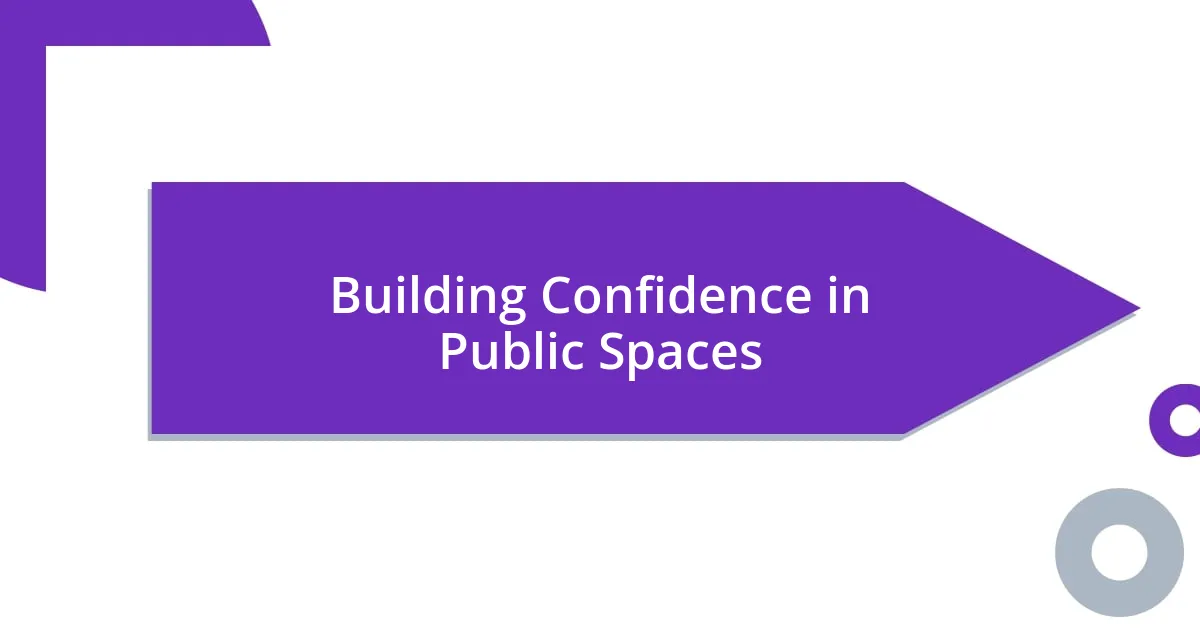Key takeaways:
- Street photography captures candid moments; blending into the environment and being non-intrusive enhances the experience.
- Finding a unique style involves infusing personal experiences and emotions into photographs, rather than just imitating others.
- Building confidence involves mindful observation and engagement with subjects to create genuine connections.
- Presenting and showcasing work thoughtfully, including storytelling through captions, significantly enhances the impact of photography.

Understanding Street Photography Basics
Street photography, at its core, is all about capturing candid moments in public spaces. I remember my first time wandering through a bustling market, feeling a mix of excitement and apprehension. What I realized then was that the essence of street photography lies in observing life as it unfolds—every gesture, every expression tells a story.
Understanding the basics involves learning to blend into your environment. I often think about how important it is to be invisible yet present. For instance, when I found myself tucked into a corner of a café, quietly observing, I witnessed an elderly couple share a laugh over their cups of tea. This moment, unplanned and natural, reinforced my belief that true magic happens when you let life flow around you.
Then there’s the importance of the right equipment; while DSLRs are amazing, I’ve found that a compact camera can sometimes be less intimidating. Have you ever noticed how a smaller camera invites more genuine interaction? I recall taking my little point-and-shoot to a street festival, and how the lightness of it allowed me to engage more fluidly with the people around me, capturing their unguarded joy. This experience taught me that confidence in street photography can often stem from simplicity and connection.

Finding Your Unique Style
Finding your unique style in street photography is an evolving journey. I’ve learned that your individual perspective shapes every image you take. When I first started, I often imitated others, but with time, I discovered the importance of infusing my own experiences into my work. For instance, during a quiet afternoon stroll, I noticed how the shadows danced on the sidewalk. Capturing that interplay of light and darkness felt like an extension of my personal narrative—a glimpse into my perspective that was distinctly mine.
It’s easy to feel pressured to conform to trends, but I encourage embracing what resonates deeply with you. A memorable moment for me was when I focused on the fleeting emotions of strangers. One day, I saw a child bursting with joy, running toward their parent. That split-second, frozen in time, became a staple of my style. I realized how meaningful it is to focus on emotions that echo my own life experiences. This approach not only distinguishes my work but also reflects the genuine emotion that connects us all.
Experimentation plays a crucial role in developing your distinct style. I often push my boundaries by choosing unconventional angles or different subjects. While exploring an abandoned subway station, I opted for an extreme low angle to capture the rawness of the environment. The results were surprising and invigorating, adding depth to my portfolio. Each shot taken this way added a layer to my vision, encapsulating the vibrancy of life in a way that feels personal and real.
| Traditional Style | Unique Style |
|---|---|
| Imitating popular photographers | Infusing personal experiences into each shot |
| Standard camera angles | Experimenting with unconventional perspectives |
| Focusing on crowded scenes | Emphasizing emotions and intimate moments |

Building Confidence in Public Spaces
Building confidence in public spaces is often a matter of mindset. Remember the first time I pointed my camera at a stranger? My heart raced—what if they objected? But over time, I learned that most people are absorbed in their own world and hardly notice you. This realization became liberating. With each click of the shutter, I began to see beyond that initial fear, allowing myself to connect with the scene rather than stress about being an intruder.
- Practice Mindful Observation: Start by simply observing your surroundings without your camera. This practice helps you absorb the ambiance and interact with the environment more naturally.
- Engage with the Scene: When I approached a group of friends laughing together, instead of aiming my camera immediately, I first shared a smile. It transformed my experience—suddenly, I wasn’t just an outsider; I was part of their moment.
- Use Discreet Equipment: I’ve often chosen a camera that feels less imposing. A smaller model not only lightens the load but also puts others at ease, making candid interactions more accessible.
- Embrace Vulnerability: Letting go of perfectionism is crucial. I once misjudged a moment and captured a blurry image at a street fair. Rather than feeling defeated, I found beauty in the chaos. Each mistake is a stepping stone toward growth.
The social dynamics of public spaces can feel daunting, but as I’ve discovered, confidence comes from pausing to acknowledge shared human experiences. Each moment I capture truly thrives on the connection I foster with my surroundings.

Mastering Camera Settings for Streets
Mastering your camera settings is essential for capturing the vibrant pulse of street life. I remember the first time I adjusted my aperture to create a beautiful bokeh effect around a group of busy pedestrians. That depth of field brought focus to their expressions while artfully blurring the background, making the moment feel intimate and alive. Isn’t it incredible how the right settings can elevate a simple scene into a powerful image?
In my experience, street photography thrives on spontaneity, which is why I often shoot in aperture-priority mode. This allows my camera to automatically adjust the shutter speed based on lighting conditions, so I can focus on the action unfolding in front of me. I once stood under a bustling overpass, and as cars zoomed overhead, I quickly shifted to a higher ISO. Capturing the movement while keeping the subjects sharp taught me the significance of adaptability in a dynamic environment.
It’s also important to consider your white balance. I learned this the hard way after a golden hour shoot that turned my colors into an unintended blue palette. Now, I consciously set my camera based on the lighting conditions—whether it’s shaded or in direct sunlight—to ensure what I see is what the lens captures. After all, have you ever stumbled upon a perfect moment only to find the colors misrepresent the scene? Mastering camera settings is about more than just technical knowledge; it’s about ensuring your images authentically reflect the stories you want to tell.

Engaging with Your Subjects
Engaging with the people I photograph often transforms the way I perceive street scenes. On one occasion, I spotted a young woman engrossed in a book at a café. Before I lifted my camera, I took a moment to sit nearby and enjoy my own drink. I smiled at her, and she smiled back—it opened the door to a genuine connection. That simple interaction made it possible for me to capture her essence without the weight of feeling intrusive. Have you ever shared a smile with a stranger that felt like a shared secret?
Establishing that rapport can turn an ordinary moment into something remarkable. I recall a bustling street market where I noticed a vendor’s animated storytelling, captivating his audience. Instead of rushing to document it, I approached him and asked about the story behind his craft. By engaging him in conversation, I learned about his passion, and in turn, I was able to take photos that reflected his enthusiasm rather than just a candid shot of him at work. Isn’t it fascinating how understanding someone’s story can add depth to your photography?
I also believe that being present is key to engaging with subjects. I once found myself in a vibrant parade, where the energy was electric. Instead of focusing solely on the visuals, I let the rhythms of music and laughter guide my lens. By staying tuned in to the atmosphere, I not only captured breathtaking moments, but I also felt fully immersed in the experience. Isn’t the goal of street photography to not just see a moment, but to feel it too? Engaging with subjects is about creating a shared experience, allowing you to document not just faces, but stories that resonate.

Analyzing and Learning from Feedback
Analyzing feedback on my street photography has been transformative for my growth as an artist. I remember showing a series of urban portraits to a fellow photographer who highlighted the tension in my compositions, which I hadn’t noticed before. It made me realize that sometimes, the most striking images are those that provoke an emotional response. Have you ever shared your work, only to uncover perspectives you hadn’t considered?
When I receive critiques, I make it a point to reflect on them constructively. After a photo walk where I focused on capturing candid moments, a mentor pointed out how I could enhance the storytelling aspect by adding context. I took that advice to heart, and now I often think about the story behind each image I capture. What narrative do you want your photographs to convey? Understanding this has made my work more intentional and impactful.
I’ve also learned to embrace both praise and criticism alike. One time, after a vibrant festival shoot, I received a comment about the energy in one of my photos that made me beam with pride. In contrast, another image didn’t resonate as much, and while it stung initially, it prompted me to rethink my approach to composition. How do you balance the emotional ups and downs of feedback? This journey has taught me to view feedback as a tool for growth, pushing me to create with even more passion and purpose.

Showcasing Your Work Effectively
When it comes to showcasing my work, I’ve discovered that presentation can elevate a photograph from simply being seen to truly being experienced. I remember attending an art exhibit where the way each piece was displayed invited conversation—it made me rethink how I share my own images. Have you ever considered how the setting and arrangement can change the viewer’s perception and emotional response? It’s fascinating how something as simple as a clean frame or well-planned layout can amplify the impact of your photography.
Social media plays a massive role in my showcasing strategy, but I’ve learned the importance of thoughtful curation. I once uploaded a spontaneous street shot without much thought, only to see it garner little interest. In contrast, when I shared a well-composed image with a compelling story attached, the feedback was overwhelmingly positive. Why do you think that is? For me, it’s all about context—providing the background allows viewers to engage with the image on a deeper level.
Additionally, I find that storytelling through captions can enhance the viewer’s experience significantly. During a recent trip to a bustling city, I captured a moment of two strangers sharing an umbrella amid a downpour. Instead of just posting the image, I shared how that moment reminded me of unexpected connections in life. As I wrote the caption, I felt a wave of nostalgia wash over me. Don’t you think a personal touch can forge a connection between the photographer and the audience? Crafting a narrative around your work not only fills in the gaps but also invites viewers to see the world through your lens.














